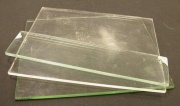Plexiglas
Description
[Plexiglas] A registered trademark for a transparent, thermoplastic Acrylic sheet. Plexiglas® is composed of Polymethyl methacrylate. It was invented by Otto Rohm and Walter Bauer of Rohm and Haas in Darmstadt Germany. They coined the name Plexiglass because it looked like Glass but could be heated and formed into many shapes. Rohm and Haas patented the product in 1933 and by 1936 was marketing the acrylic sheets under the name of Plexiglas® as a non-breakable substitute for glass. The clear, lightweight material can be scratched easily and is marred by solvents. It also accumulates a static charge that attracts particles. Plexiglas® is used for signs, lens, containers, windows, skylights, windshields, protective glazing, chalkboards and furniture. Some types of Plexiglas® sold by Arkema are:
- Plexiglas® G UF-4: transmits less than 10% UV and does not have a yellow cast. Transmission starting at 385nm. Overall better visible light transmission; sheet with slightly better edge color.[1]
- Plexiglas® G UF-3: transmits less than 2% UV and has a slight yellow cast. Transmission starting at 395nm. [2]
In the United States, Plexiglas® is also sold under the trademark Acrylite®. Some forms of Acrylite® are:
- Acrylite® OP3 MR1: UV filtering mar resistant. 92% light transmission. Transparent. Mar resistant coating (one-sided). [3]
- Acrylite® OP3 P99: UV filtering. 91.9% light transmission. Non-glare surface (one-sided). Soft matte finish. [4]
- Acrylite® OP3: UV filtering. 92% light transmission. Transparent. High-gloss surface. [5]
Synonyms and Related Terms
polymethylmethacrylate (PMMA); polimetilmetacrilato (Esp.); acrylic
Brand names: Lucite® [Lucite]; Perspex® [Lucite); Plexiglas® [Arkema]; Altuglas® [Arkema]; Acrylite® [Piedmont Plastics]
Applications
Plexiglas® is used for a variety of exhibit related applications:
- Mount making
- Glazing/framing
- Vitrines
Personal Risks
Grinding, sanding, and/or sawing can cause dust which may result in respiratory hazard. Also, the product may release fumes and/or vapor of variable composition, depending on processing time and temperature.
Arkema: SDS
Acrylite: SDS
Collection Risks
Links to Oddy Test results posted on AIC Wiki Materials Database Pages for individual materials below:
° Plexiglas G tested in 2019.
° Cast Polymethylmethacrylate (PMMA) tested in 2019.
° Plexi Glass tested in 2016.
Working Properties
Extruded acrylic sheets are recommended for mount making as it allows for forming, bending, and finishing. Cell cast is recommended for framing and display cases because it has better clarity. [6]
A variety of saws can be used to cut Plexiglas®: circular, band, scroll, saber, hole, and veneer saws. Routers can also be used on Plexiglas®. Plexiglas® can also be turned on a lathe to give a semi-matte surface. When drilling, best results are obtained when using a modified standard twist drill. Specially ground drills for Plexiglas® acrylic sheet are available.
After cutting Plexiglas® acrylic sheeting it is often desirable to scrape the edges to remove nicks or burrs and improve the appearance.[7]
Plexiglas® can be joined using methylene chloride (solvent-dissolving acrylic), acetoxy cure silicone sealants, or an epoxy; these joints are strong enough for loadbearing for medium to heavy weights, but bending acrylic sheeting is stronger. Plexiglas® acrylic sheeting is a thermoplastic and can be shaped once pre-heated between 325°F and 350°F, but the sheets can be cold formed as well by springing the material into a curved channel support.[8]
Naphtha or kerosene can be used to remove grease stains and self-adhesive residue, but make sure to use in well ventilated areas.
Shallow scratches can be removed with fine abrasives; pre-polishes for automotive finishes can be used if scratches are minimal. Scratch removal can be very laborious. [9]
Forms and Sizes
Plexiglas® G UF-4 and UF-3:
Sheet sizes: 48x96", 60x90", 72x96"
Thicknesses: 0.118, 0.177, 0.236, 0.354, and 0.472”
Acrylite:
- OP3 MR1: 0.118” thick , 12-69” x 12-48”
- OP3 P99: 0.098 or 0.118” thick, 12-96” x 12-48”
- OP3: 0.118” or 0.177” thick, 12-83” x 12-52”
- OP3 oversized: 0.177” thick, 126” x 75”
Resources and Citations
- ↑ Arkema: Plexiglas® G UF-3 and UF-4 Brochure
- ↑ Arkema: Plexiglas® G UF-3 and UF-4 Brochure
- ↑ Acrylite: OP3 MR1
- ↑ Acrylite: OP3 P99
- ↑ Acrylite: OP3
- ↑ CCI Technical Bulletin: Products Used in Preventive Conservation, Poly(methyl methacrylate) (PMMA and acrylic)
- ↑ Arkema: Plexiglas® Literature (Fabrication Manual)
- ↑ Arkema: Plexiglas® Literature (Optical and Transmission Characteristics)
- ↑ CCI Notes: Cleaning Glass and Acrylic Display Cases
- Arkema Plexiglas® Website
- Acrylite Website
- Röhm GmbH Plexiglas Website
- Kaela Nurmi, contributed information, MWG group, 2020.
- Jean Tétreault, “Poly(methyl methacrylate) (PMMA and acrylic),” in “Products used in Preventative Conservtion – Technical Bulletin 32,” Canadian Conservation Institute, 2017, Link
- James Harwood, submitted information, University of Akron, September 2008.
- G.S.Brady, Materials Handbook, McGraw-Hill Book Co., New York, 1971 Comment: p. 11
- The American Heritage Dictionary or Encarta, via Microsoft Bookshelf 98, Microsoft Corp., 1998
- Dictionary of Building Preservation, Ward Bucher, ed., John Wiley & Sons, Inc., New York City, 1996
- Ralph Mayer, A Dictionary of Art Terms and Techniques, Harper and Row Publishers, New York, 1969 (also 1945 printing)
- Hermann Kuhn, Conservation and Restoration of Works of Art and Antiquities, Butterworths, London, 1986
- Thomas C. Jester (ed.), Twentieth-Century Building Materials, McGraw-Hill Companies, Washington DC, 1995
- Book and Paper Group, Paper Conservation Catalog, AIC, 1984, 1989
- Marie Svoboda, Conservation Survey Index, unpublished, 1997
- Teri Hensick, contributed information, 1998
- Website: www.rohmhaas.com/company/history
